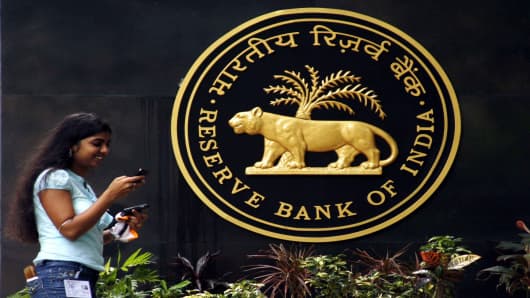India's central bank lowered its key policy rate as expected for the first time in nine months to support an economy set for its slowest growth in a decade, but signaled there was less room for aggressive cuts in future due to concerns over inflation.
The Reserve Bank of India cut the policy repo rate by 25 basis points to 7.75 percent, in line with a Reuters poll earlier this month.
(Read More: Indian Finance Minister Makes Case for Ratings Upgrade)
The RBI unexpectedly also reduced the cash reserve ratio (CRR), the share of deposits banks must keep with the central bank by 25 bps to 4.00 percent, which will infuse an additional 180 billion rupees into the banking system.
India's headline inflation rate moderated to a three-year low of 7.18 percent in December, and the central bank said there was likelihood that inflation would remain rangebound around current levels heading into 2013/14 fiscal year starting April.
"This provides space, albeit limited, for monetary policy to give greater emphasis to growth risks," the central bank said in its quarterly monetary policy review.
Bond and stock markets were largely unmoved as dealers had already priced in a quarter percentage point rate cut. The 10-year bond yield was flat at around 7.87 percent. India's main NSE index was also flat, with the bank sub-index up 0.2 percent, paring initial stronger gains.
The Indian rupee strengthened to 53.79 to the dollar from around 53.84 before the decision.
"RBI has not abandoned its cautious stance, stressing on the 'calibrated and limited' nature of rate support (from) hereon," said Radhika Rao, economist, Forecast Pte in Singapore.
"The scale of rate cuts is closely tied to the government's sustained efforts to correct the twin imbalances and moderating inflation trajectory."
The central bank however reiterated its concerns over a bloated fiscal and current account deficits (CAD) adding that its pro-growth stance will be conditioned by the management of the risks posed by them.
"Financing the CAD with increasingly risky and volatile flows increases the economy's vulnerability to sudden shifts in risk appetite and liquidity preference, potentially threatening macroeconomic and exchange rate stability," the RBI said.
(Read More: India Joins the Debate Over Taxing the Rich)
Since a 50 basis point cut in April, the central bank had kept interest rates on hold as inflation stayed stubbornly high, ignoring repeated calls from the government for a cut.
Having grown at near-double-digit pace before the Lehman Brothers crisis, the economy has suffered a rapid deceleration.
The RBI cut its GDP growth forecast for Asia's third-largest economy to 5.5 percent for the current fiscal year, from 5.8 percent previously, and lowered its projection for headline inflation in March to 6.8 percent from 7.5 percent earlier.


